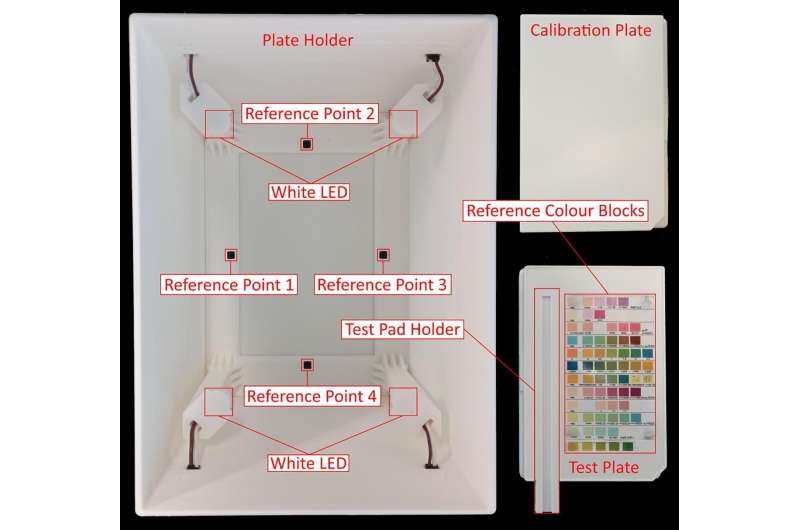This article has been reviewed according to Science X's editorial process and policies. Editors have highlighted the following attributes while ensuring the content's credibility:
fact-checked
trusted source
proofread
Point-of-care kidney disease testing via quantitative urinalysis with commercial reagent strips

Kidney disease is a growing global problem, with a new portable device developed by Flinders University showcasing some of the science and innovation being thrown at the issue.
With chronic kidney disease affecting between 8% and 10% of the world's population, the device could be used for more regular monitoring of these patients for disease progression and for screening high-risk populations for early interventions.
Accessible, affordable urinalysis to assess kidney function could be a boon in remote areas of Australia, testing at home as well as in low-economic and developing countries, says Professor Youhong Tang, a mechanical, material and manufacturing engineering researcher who has published results of the new device's latest tests.
"Our device has been designed as an open platform so it has the capability to be used not just for urinalysis, but for different types of tests using colorimetric test strips and for test strips from any manufacturer."
In a case study 57 human urine samples were collected from Flinders Medical Center over a period of six months and the readings obtained by the device were compared with clinical values provided by SA Pathology. The article, "Point-of-care image-based quantitative urinalysis with commercial reagent strips: Design and clinical evaluation," has been published in a special edition of Methods.
Study co-author Dr. Damian Tohl says the readings from the new device showed a strong correlation with the clinical values and an improvement on the traditional method of reading the commercially available paper test strips.
"We have developed a portable colorimetric paper test strip reader that uses a camera and image processing software to automatically obtain a reading," says Dr. Tohl.

"Paper-based colorimetric tests are popular because they are inexpensive and quick and easy to perform, however, reading the result requires comparison of the test strip with reference color blocks and may be affected by variations in ambient light and color perception between users.
"Our device includes a calibration process so that results are invariant to variations in ambient light to produce quantitative measurements with improved accuracy."
The Flinders University research team has filed for an Australian patent on the strength of these results, and further development is progressing.
The incidence of chronic kidney disease (CKD) is increasing in Australia and worldwide, placing a significant burden on health care systems and economies.
Aboriginal and Torres Straits Islander people are twice as likely to develop CKD and five times more likely to develop kidney failure requiring dialysis compared with non-Indigenous Australians. Diagnosis of CKD depends on a general check for weight and diet and tests for blood pressure, estimated glomerular filtration rated and spot urine albumin to creatinine ratio.
The main indicator of kidney function is a person's blood level of creatinine, a waste product of the body produced by muscles and excreted by the kidneys. If kidney function is reduced, creatinine accumulates in the blood leading to an elevated level when a blood test is checked.
High blood pressure (hypertension) and diabetes are the most common causes of kidney disease. Most people have no symptoms until CKD is advanced. A person can lose up to 90% of their kidney functions before experiencing any symptoms.
More information: Damian Tohl et al, Point-of-care image-based quantitative urinalysis with commercial reagent strips: Design and clinical evaluation, Methods (2024). DOI: 10.1016/j.ymeth.2024.02.002





















